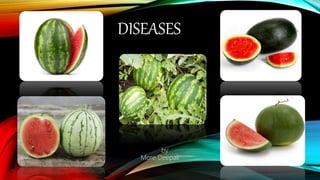Diseases of watermelon
•Download as PPTX, PDF•
6 likes•3,350 views
The document discusses several diseases that affect cucurbit crops including bacterial fruit blotch, gummy stem blight, cucurbit green mottle mosaic virus, and fusarium wilt. It describes the symptoms caused by each disease and provides information on the conditions required for disease development such as temperature, humidity, and how the pathogens are spread. Primary sources of infection include contaminated seeds, soil, irrigation water, machinery, and human handling of infected plants. Warm, wet conditions generally favor disease development.
Report
Share
Report
Share

Recommended
Recommended
More Related Content
What's hot
What's hot (20)
Major diseases of Rice and their management in Nepal 

Major diseases of Rice and their management in Nepal
Similar to Diseases of watermelon
vegediagnostic and management of bacterial diseases in vegetables

diagnostic and management of bacterial diseases in vegetablesPMAS-Arid Agriculture University Rawalpindi
Similar to Diseases of watermelon (20)
diagnostic and management of bacterial diseases in vegetables

diagnostic and management of bacterial diseases in vegetables
1. International Training Workshop on Maize production in Bhutan.pptx

1. International Training Workshop on Maize production in Bhutan.pptx
Recently uploaded
Antibiotics are medicines that fight infections caused by bacteria in humans and animals by either killing the bacteria or making it difficult for the bacteria to grow and multiply. Bacteria are germsABHISHEK ANTIBIOTICS PPT MICROBIOLOGY // USES OF ANTIOBIOTICS TYPES OF ANTIB...

ABHISHEK ANTIBIOTICS PPT MICROBIOLOGY // USES OF ANTIOBIOTICS TYPES OF ANTIB...ABHISHEK SONI NIMT INSTITUTE OF MEDICAL AND PARAMEDCIAL SCIENCES , GOVT PG COLLEGE NOIDA
Bioenergetics is an important domain in biology. This presentation has explored ATP production and its optimum utilization in biological systems along with certain theories and experiments to give a bird's eye view of this important issue.Energy is the beat of life irrespective of the domains. ATP- the energy curre...

Energy is the beat of life irrespective of the domains. ATP- the energy curre...Nistarini College, Purulia (W.B) India
Recently uploaded (20)
TransientOffsetin14CAftertheCarringtonEventRecordedbyPolarTreeRings

TransientOffsetin14CAftertheCarringtonEventRecordedbyPolarTreeRings
The Mariana Trench remarkable geological features on Earth.pptx

The Mariana Trench remarkable geological features on Earth.pptx
Role of AI in seed science Predictive modelling and Beyond.pptx

Role of AI in seed science Predictive modelling and Beyond.pptx
Daily Lesson Log in Science 9 Fourth Quarter Physics

Daily Lesson Log in Science 9 Fourth Quarter Physics
Porella : features, morphology, anatomy, reproduction etc.

Porella : features, morphology, anatomy, reproduction etc.
development of diagnostic enzyme assay to detect leuser virus

development of diagnostic enzyme assay to detect leuser virus
ABHISHEK ANTIBIOTICS PPT MICROBIOLOGY // USES OF ANTIOBIOTICS TYPES OF ANTIB...

ABHISHEK ANTIBIOTICS PPT MICROBIOLOGY // USES OF ANTIOBIOTICS TYPES OF ANTIB...
Genome Projects : Human, Rice,Wheat,E coli and Arabidopsis.

Genome Projects : Human, Rice,Wheat,E coli and Arabidopsis.
Energy is the beat of life irrespective of the domains. ATP- the energy curre...

Energy is the beat of life irrespective of the domains. ATP- the energy curre...
Diseases of watermelon
- 2. BACTERIAL FRUIT BLOTCH Water-soaked lesion on a watermelon cotyledon Tan veinal necrosis on a melon leaf Watermelon leaf collected from the field with typical foliar lesions
- 3. Cracking of watermelon rind Epidermal cracking, atypical without water-soaking Honeydew melon fruit infection “Classic” bacterial fruit blotch symptoms
- 4. External fruit symptoms on edible watermelon External fruit symptoms on edible watermelon
- 5. CONDITIONS FOR DISEASE DEVELOPMENT • Seed borne and seed transmitted pathogen • Primary source of pathogen – contaminated seeds or infected transplants • Pathogen does not survive in soil for long time in absence of host tissue • Infection and disease development favored by high relative humidity, heavy dew formation or rainfall, combined with warm temperatures. • The bacterium is spread by splashing rain, irrigation water, people and equipment. • Fruit may be infected through stomata early in development. • Infection occurs before formation of the waxy layer in watermelon fruit. Hence, unwounded mature fruit are not considered to be susceptible to infection. • although abrasions and other wounds may allow entry of the pathogen leading to fruit infection. • Acidovorax citrulli is not known to move systemically within the plant.
- 6. GUMMY STEM BLIGHT Seedling infection. Brown, water-soaked stem section. Fruiting bodies (pycnidia) forming near the crown area
- 8. • Open Field: The fungus overwinters on infected cucurbit crop debris and cucurbit volunteers, seed-borne. • Wounds caused by pruning, insects or field work can be important entry points for the fungus. • The disease is most serious in open field production during periods of moderate temperatures and wet weather. The optimum temperature range for infection is 20–25°C (68–77°F). • Protected Culture: Cool night temp. and high humidity favor disease development. • Infection of open flowers can lead to serious fruit quality problems. CONDITIONS FOR DISEASE DEVELOPMENT
- 9. CGMMV Mottling on mature watermelon leaves watermelon fruit yellowing
- 10. External (top left) and internal symptoms
- 11. • contaminated seed and soil are the most common. It can readily infect plants and survive and spread by several means, including: • infection of roots in soil that is contaminated with infected plant debris. The virus can spread through root-to-root contact in water . • by mechanical transfer, where plants are frequently pruned, staked, handled or touched. • This can occur via contaminated machinery, clothing, or even the hands of persons who have come in contact with infected plants • seed harvested from infected plants Transmission
- 12. FUSARIUM WILT Wilting of runners on a watermelon Vascular discoloration mycelial growth.
- 13. • favored by warm soil temperatures. • Wilting of the lower leaves occurs at warm temperatures [25–28ºC (77–82ºF)] and the leaves recover under cooler temperatures. • The fungus survives as chlamydospores in the soil and in plant debris. • The chlamydospores are readily disseminated in soil and in debris during cultivation of fields, in irrigation water, by wind-blown soil and workers. CONDITIONS FOR DISEASE DEVELOPMENT
